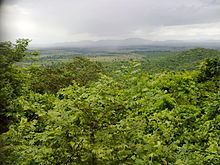 | ||
Forests
There are two basic kinds of forest here; in the northeast region of the state the forest is classified as the tropical-moist-deciduous type, blanketing hills, plateaus and other high-altitude isolated areas; in the southwest the tropical-dry-deciduous variety dominate.
Contents
Orissa's forests are vast. Out of the total geographical area of 155,707 km2, the State records 52,472 km2 (~33%) as some version of forest. The actual forest cover may be less, according to the Forest Survey of India, rosewood, sal, piasal, sanghvan and haldi. The forest's naturally vigorous growth accounts for a tremendous wealth of biodiversity, filling many catalogues of the wild plant and animal species dwelling within.
The state has declared large parcels of land as protected areas with the purpose being to allow animals and plants who are sensitive to cohabitation with humans places of relative freedom from interference and habitat loss. These protected areas constitute 10.37% of the total forest area and 4.1% of the total geographical area of the state.
Forest flora
The state is home to about 7,000 plant species including 120 orchid species and 63 varieties of mangrove trees which make the state second largest mangrove ecosystem in India.
A vast variety of other plants are also found in the state, as in the following:
Forest fauna
The IUCN Red List has recorded a total of 473 species of birds and 86 species of mammals, 19 species of amphibians and 110 species of reptiles including three crocodilian species. Out of these around 54 species are considered endangered. Home to a variety of wild animals, the state has declared considerable tracts of land as areas protected for these animals only. These protected areas constitute 10.37% of the total forest area and 4.1% of the total geographical area of the state. Not only this, the state also has the distinction of possessing three mass nesting beaches of endangered olive ridley sea turtles which makes it the largest nesting ground of the species.
The state has three mass nesting beaches of endangered olive ridley sea turtles which when combined together makes it the world's largest nesting ground for this species.
Indenting Orissa's ocean coast is Chilika lagoon, a semi-saline wetland used by many species of migratory birds, and also which the endangered Irrawaddy dolphin uses as part of its range. In spite of considerable human interactivity here, the rare dolphin survives. The Orissa government is conducting various programs to protect the species.
Other animals that call Orissa home, or part-time home are listed below.
